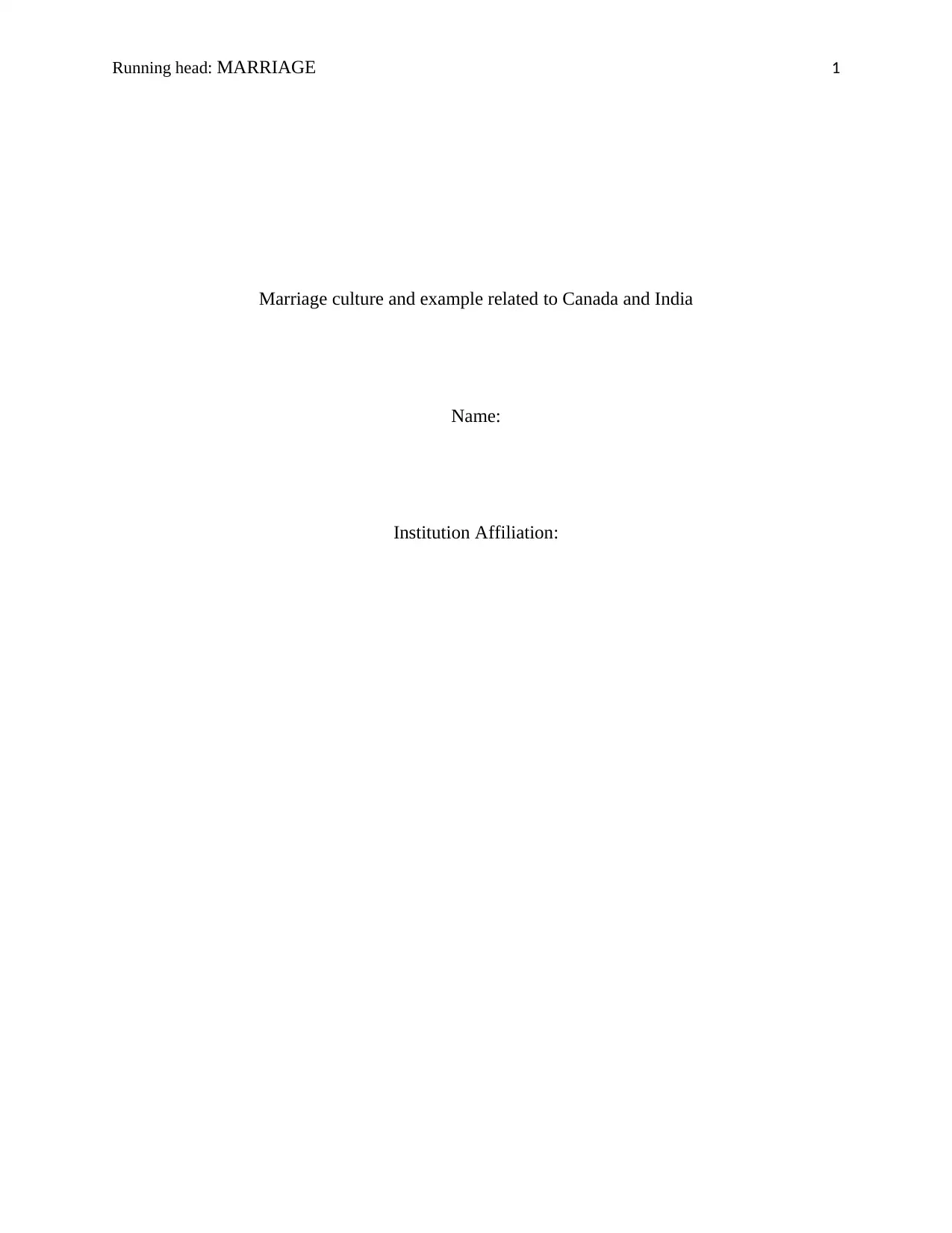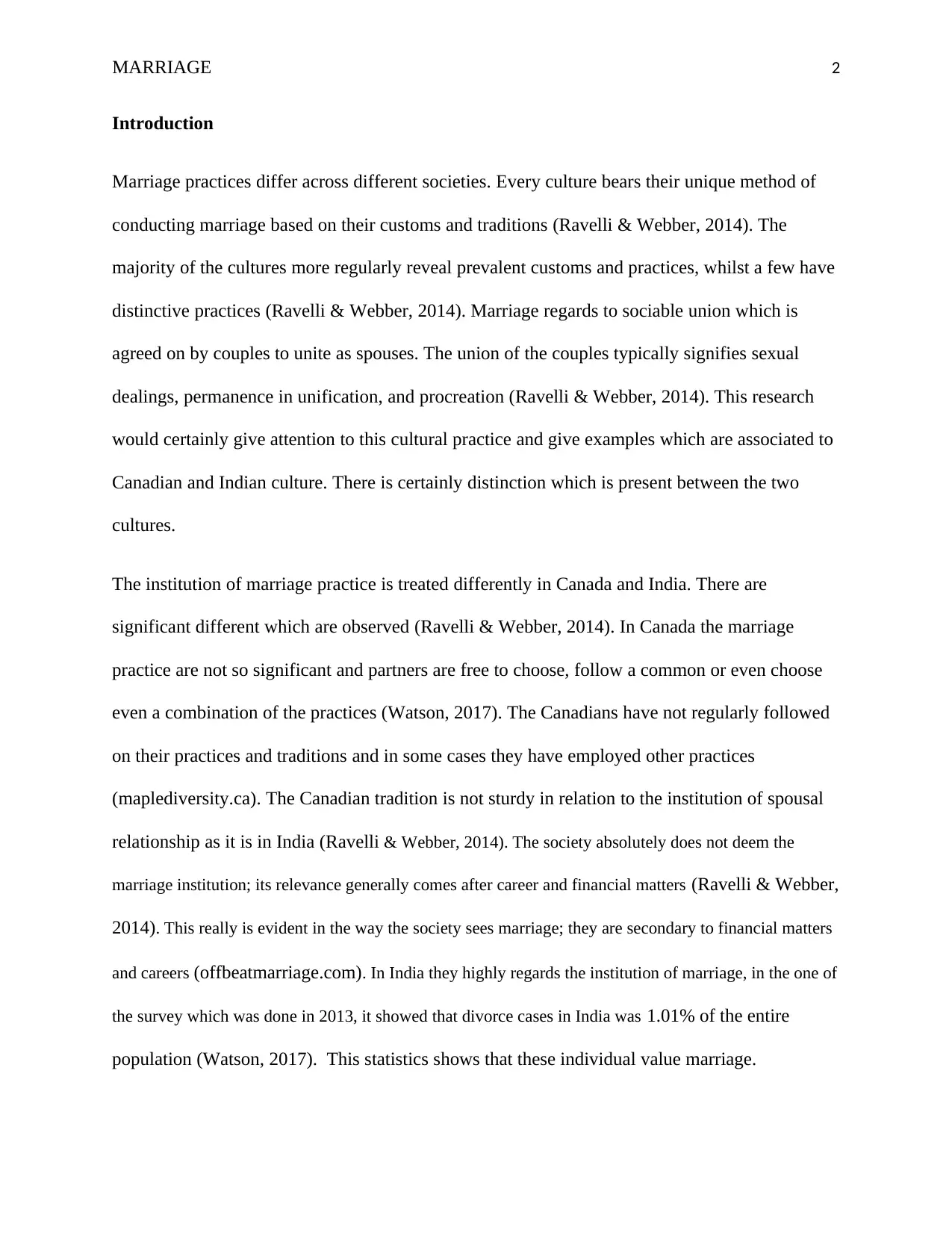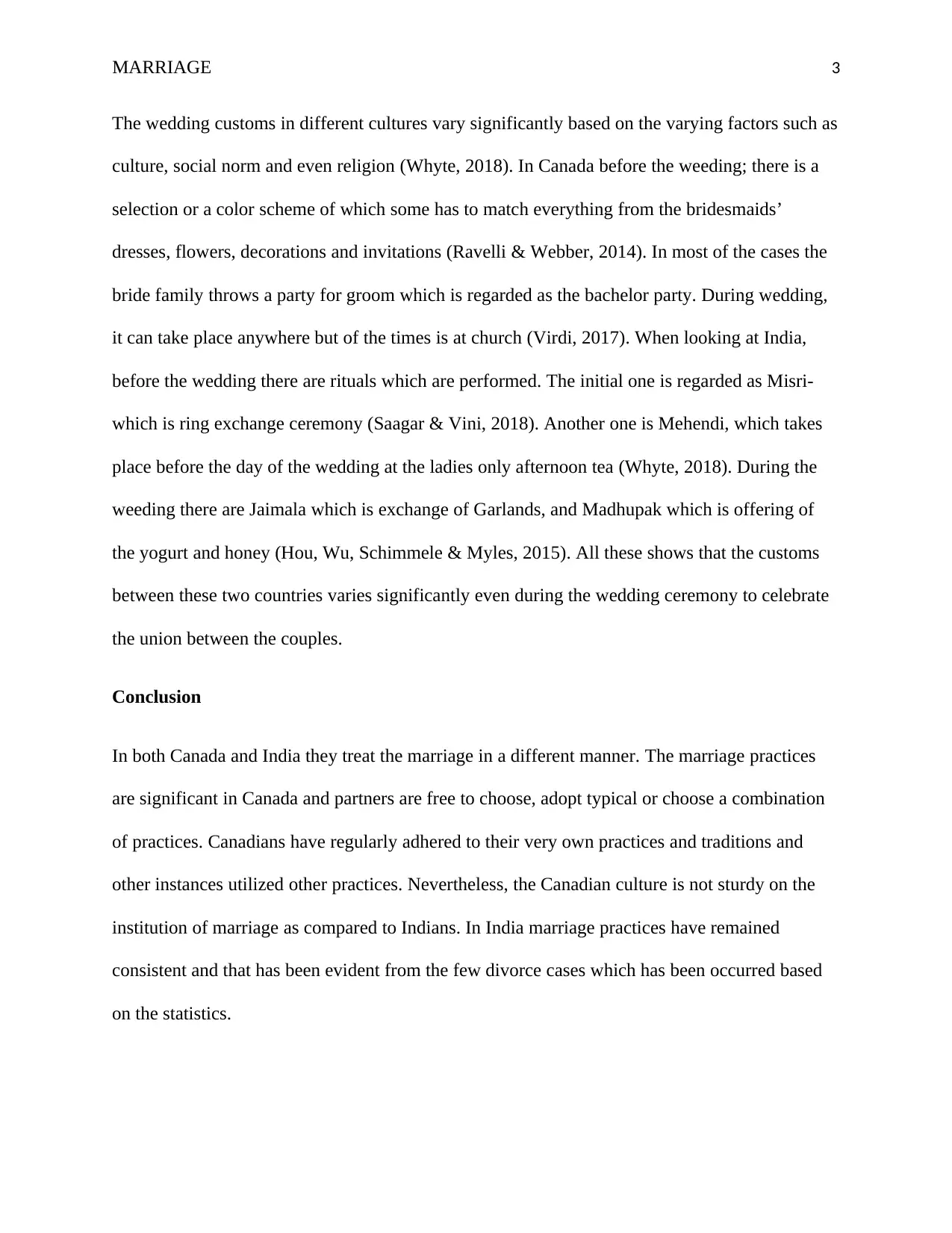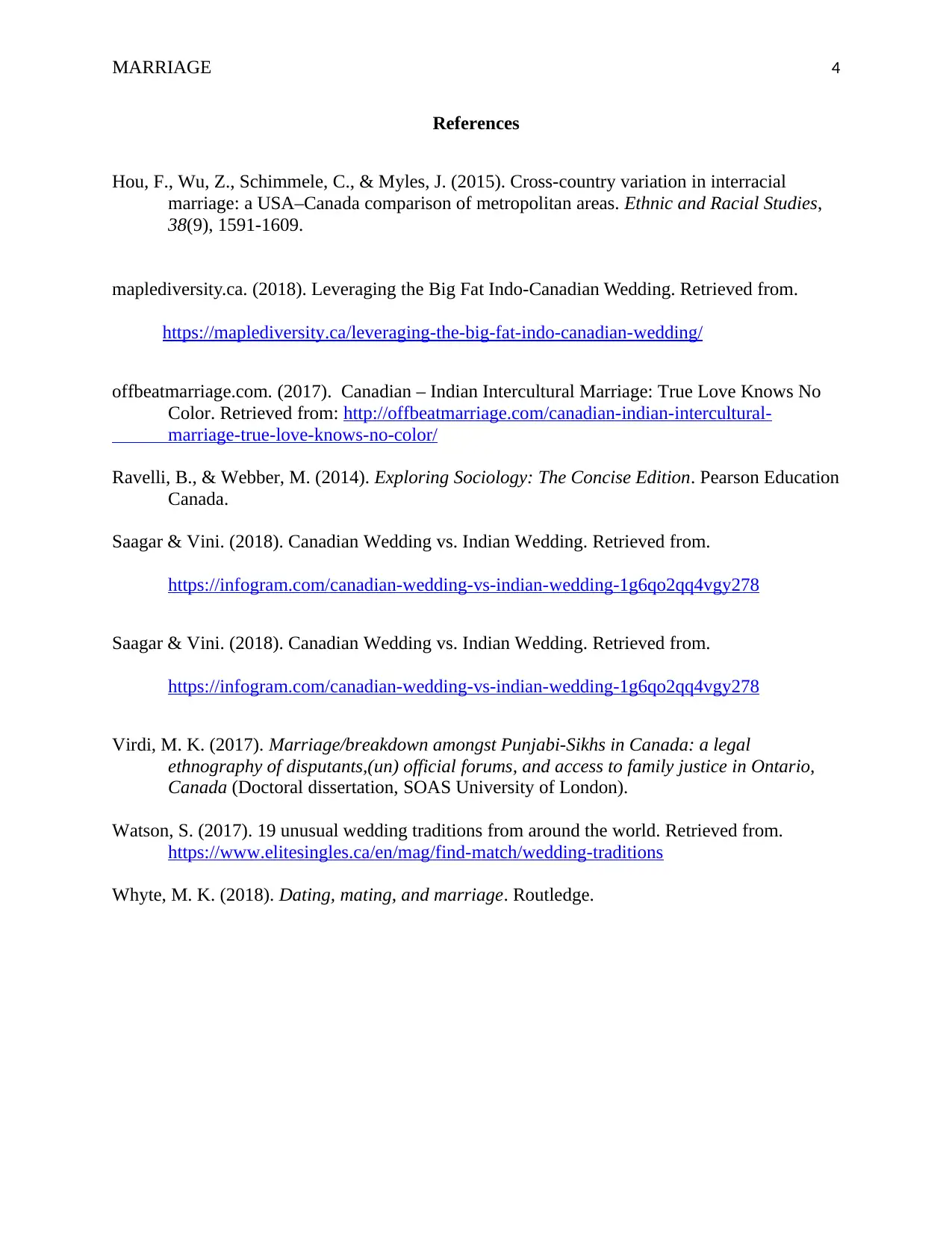Marriage Traditions: Exploring Cultural Variations in Canada and India
VerifiedAdded on 2021/04/21
|4
|934
|213
Essay
AI Summary
This essay provides a comparative analysis of marriage practices in Canada and India. It explores the cultural differences in how marriage is viewed and conducted, highlighting the varying importance placed on the institution of marriage in each society. The essay examines pre-wedding rituals, wedding ceremonies, and societal expectations, drawing upon scholarly sources to illustrate these differences. It discusses the significance of traditions, societal norms, and religious influences on marriage customs in both countries. The essay also touches upon divorce rates and the impact of cultural values on marital stability. Ultimately, it reveals the diverse approaches to marriage, reflecting the unique cultural landscapes of Canada and India.

Running head: MARRIAGE 1
Marriage culture and example related to Canada and India
Name:
Institution Affiliation:
Marriage culture and example related to Canada and India
Name:
Institution Affiliation:
Paraphrase This Document
Need a fresh take? Get an instant paraphrase of this document with our AI Paraphraser

MARRIAGE 2
Introduction
Marriage practices differ across different societies. Every culture bears their unique method of
conducting marriage based on their customs and traditions (Ravelli & Webber, 2014). The
majority of the cultures more regularly reveal prevalent customs and practices, whilst a few have
distinctive practices (Ravelli & Webber, 2014). Marriage regards to sociable union which is
agreed on by couples to unite as spouses. The union of the couples typically signifies sexual
dealings, permanence in unification, and procreation (Ravelli & Webber, 2014). This research
would certainly give attention to this cultural practice and give examples which are associated to
Canadian and Indian culture. There is certainly distinction which is present between the two
cultures.
The institution of marriage practice is treated differently in Canada and India. There are
significant different which are observed (Ravelli & Webber, 2014). In Canada the marriage
practice are not so significant and partners are free to choose, follow a common or even choose
even a combination of the practices (Watson, 2017). The Canadians have not regularly followed
on their practices and traditions and in some cases they have employed other practices
(maplediversity.ca). The Canadian tradition is not sturdy in relation to the institution of spousal
relationship as it is in India (Ravelli & Webber, 2014). The society absolutely does not deem the
marriage institution; its relevance generally comes after career and financial matters (Ravelli & Webber,
2014). This really is evident in the way the society sees marriage; they are secondary to financial matters
and careers (offbeatmarriage.com). In India they highly regards the institution of marriage, in the one of
the survey which was done in 2013, it showed that divorce cases in India was 1.01% of the entire
population (Watson, 2017). This statistics shows that these individual value marriage.
Introduction
Marriage practices differ across different societies. Every culture bears their unique method of
conducting marriage based on their customs and traditions (Ravelli & Webber, 2014). The
majority of the cultures more regularly reveal prevalent customs and practices, whilst a few have
distinctive practices (Ravelli & Webber, 2014). Marriage regards to sociable union which is
agreed on by couples to unite as spouses. The union of the couples typically signifies sexual
dealings, permanence in unification, and procreation (Ravelli & Webber, 2014). This research
would certainly give attention to this cultural practice and give examples which are associated to
Canadian and Indian culture. There is certainly distinction which is present between the two
cultures.
The institution of marriage practice is treated differently in Canada and India. There are
significant different which are observed (Ravelli & Webber, 2014). In Canada the marriage
practice are not so significant and partners are free to choose, follow a common or even choose
even a combination of the practices (Watson, 2017). The Canadians have not regularly followed
on their practices and traditions and in some cases they have employed other practices
(maplediversity.ca). The Canadian tradition is not sturdy in relation to the institution of spousal
relationship as it is in India (Ravelli & Webber, 2014). The society absolutely does not deem the
marriage institution; its relevance generally comes after career and financial matters (Ravelli & Webber,
2014). This really is evident in the way the society sees marriage; they are secondary to financial matters
and careers (offbeatmarriage.com). In India they highly regards the institution of marriage, in the one of
the survey which was done in 2013, it showed that divorce cases in India was 1.01% of the entire
population (Watson, 2017). This statistics shows that these individual value marriage.

MARRIAGE 3
The wedding customs in different cultures vary significantly based on the varying factors such as
culture, social norm and even religion (Whyte, 2018). In Canada before the weeding; there is a
selection or a color scheme of which some has to match everything from the bridesmaids’
dresses, flowers, decorations and invitations (Ravelli & Webber, 2014). In most of the cases the
bride family throws a party for groom which is regarded as the bachelor party. During wedding,
it can take place anywhere but of the times is at church (Virdi, 2017). When looking at India,
before the wedding there are rituals which are performed. The initial one is regarded as Misri-
which is ring exchange ceremony (Saagar & Vini, 2018). Another one is Mehendi, which takes
place before the day of the wedding at the ladies only afternoon tea (Whyte, 2018). During the
weeding there are Jaimala which is exchange of Garlands, and Madhupak which is offering of
the yogurt and honey (Hou, Wu, Schimmele & Myles, 2015). All these shows that the customs
between these two countries varies significantly even during the wedding ceremony to celebrate
the union between the couples.
Conclusion
In both Canada and India they treat the marriage in a different manner. The marriage practices
are significant in Canada and partners are free to choose, adopt typical or choose a combination
of practices. Canadians have regularly adhered to their very own practices and traditions and
other instances utilized other practices. Nevertheless, the Canadian culture is not sturdy on the
institution of marriage as compared to Indians. In India marriage practices have remained
consistent and that has been evident from the few divorce cases which has been occurred based
on the statistics.
The wedding customs in different cultures vary significantly based on the varying factors such as
culture, social norm and even religion (Whyte, 2018). In Canada before the weeding; there is a
selection or a color scheme of which some has to match everything from the bridesmaids’
dresses, flowers, decorations and invitations (Ravelli & Webber, 2014). In most of the cases the
bride family throws a party for groom which is regarded as the bachelor party. During wedding,
it can take place anywhere but of the times is at church (Virdi, 2017). When looking at India,
before the wedding there are rituals which are performed. The initial one is regarded as Misri-
which is ring exchange ceremony (Saagar & Vini, 2018). Another one is Mehendi, which takes
place before the day of the wedding at the ladies only afternoon tea (Whyte, 2018). During the
weeding there are Jaimala which is exchange of Garlands, and Madhupak which is offering of
the yogurt and honey (Hou, Wu, Schimmele & Myles, 2015). All these shows that the customs
between these two countries varies significantly even during the wedding ceremony to celebrate
the union between the couples.
Conclusion
In both Canada and India they treat the marriage in a different manner. The marriage practices
are significant in Canada and partners are free to choose, adopt typical or choose a combination
of practices. Canadians have regularly adhered to their very own practices and traditions and
other instances utilized other practices. Nevertheless, the Canadian culture is not sturdy on the
institution of marriage as compared to Indians. In India marriage practices have remained
consistent and that has been evident from the few divorce cases which has been occurred based
on the statistics.
⊘ This is a preview!⊘
Do you want full access?
Subscribe today to unlock all pages.

Trusted by 1+ million students worldwide

MARRIAGE 4
References
Hou, F., Wu, Z., Schimmele, C., & Myles, J. (2015). Cross-country variation in interracial
marriage: a USA–Canada comparison of metropolitan areas. Ethnic and Racial Studies,
38(9), 1591-1609.
maplediversity.ca. (2018). Leveraging the Big Fat Indo-Canadian Wedding. Retrieved from.
https://maplediversity.ca/leveraging-the-big-fat-indo-canadian-wedding/
offbeatmarriage.com. (2017). Canadian – Indian Intercultural Marriage: True Love Knows No
Color. Retrieved from: http://offbeatmarriage.com/canadian-indian-intercultural-
marriage-true-love-knows-no-color/
Ravelli, B., & Webber, M. (2014). Exploring Sociology: The Concise Edition. Pearson Education
Canada.
Saagar & Vini. (2018). Canadian Wedding vs. Indian Wedding. Retrieved from.
https://infogram.com/canadian-wedding-vs-indian-wedding-1g6qo2qq4vgy278
Saagar & Vini. (2018). Canadian Wedding vs. Indian Wedding. Retrieved from.
https://infogram.com/canadian-wedding-vs-indian-wedding-1g6qo2qq4vgy278
Virdi, M. K. (2017). Marriage/breakdown amongst Punjabi-Sikhs in Canada: a legal
ethnography of disputants,(un) official forums, and access to family justice in Ontario,
Canada (Doctoral dissertation, SOAS University of London).
Watson, S. (2017). 19 unusual wedding traditions from around the world. Retrieved from.
https://www.elitesingles.ca/en/mag/find-match/wedding-traditions
Whyte, M. K. (2018). Dating, mating, and marriage. Routledge.
References
Hou, F., Wu, Z., Schimmele, C., & Myles, J. (2015). Cross-country variation in interracial
marriage: a USA–Canada comparison of metropolitan areas. Ethnic and Racial Studies,
38(9), 1591-1609.
maplediversity.ca. (2018). Leveraging the Big Fat Indo-Canadian Wedding. Retrieved from.
https://maplediversity.ca/leveraging-the-big-fat-indo-canadian-wedding/
offbeatmarriage.com. (2017). Canadian – Indian Intercultural Marriage: True Love Knows No
Color. Retrieved from: http://offbeatmarriage.com/canadian-indian-intercultural-
marriage-true-love-knows-no-color/
Ravelli, B., & Webber, M. (2014). Exploring Sociology: The Concise Edition. Pearson Education
Canada.
Saagar & Vini. (2018). Canadian Wedding vs. Indian Wedding. Retrieved from.
https://infogram.com/canadian-wedding-vs-indian-wedding-1g6qo2qq4vgy278
Saagar & Vini. (2018). Canadian Wedding vs. Indian Wedding. Retrieved from.
https://infogram.com/canadian-wedding-vs-indian-wedding-1g6qo2qq4vgy278
Virdi, M. K. (2017). Marriage/breakdown amongst Punjabi-Sikhs in Canada: a legal
ethnography of disputants,(un) official forums, and access to family justice in Ontario,
Canada (Doctoral dissertation, SOAS University of London).
Watson, S. (2017). 19 unusual wedding traditions from around the world. Retrieved from.
https://www.elitesingles.ca/en/mag/find-match/wedding-traditions
Whyte, M. K. (2018). Dating, mating, and marriage. Routledge.
1 out of 4
Your All-in-One AI-Powered Toolkit for Academic Success.
+13062052269
info@desklib.com
Available 24*7 on WhatsApp / Email
![[object Object]](/_next/static/media/star-bottom.7253800d.svg)
Unlock your academic potential
Copyright © 2020–2025 A2Z Services. All Rights Reserved. Developed and managed by ZUCOL.